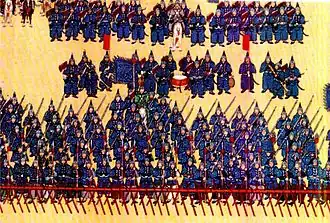Siege of Kaungton
| Siege of Kaungton | |||||||
|---|---|---|---|---|---|---|---|
| Part of the Sino–Burmese War | |||||||
| |||||||
| Belligerents | |||||||
|
|
| ||||||
| Commanders and leaders | |||||||
|
|
| ||||||
| Strength | |||||||
| Unknown | 25,000 | ||||||
| Casualties and losses | |||||||
| Unknown | Most of the army destroyed | ||||||
The Siege of Kaungton was a battle between the Qing Dynasty of China and the Konbaung Dynasty of Burma. The Chinese army led by Yang Yingju of 25,000 men was annihilated by the Burmese troops.
Prelude

After Liu Zao's defeat at the Siege of Kengtung (1765) and suicide, the Qianlong Emperor appointed Yang Yingju to take command of the Chinese army. He arrived in the summer of 1766 to take command.[1] Unlike Liu's invasion of Kengtung, located far away from the Burmese heartland, Yang was determined to strike Upper Burma directly. He reportedly planned to place a Qing claimant on the Burmese throne.[2] Yang's planned path of invasion was via Bhamo and down the Irrawaddy River to Ava. The Burmese knew the route of invasion in advance, and were prepared. Hsinbyushin's plan was to lure the Chinese into Burmese territory, and then surround them. The Burmese commander in the field Balamindin was ordered to give up Bhamo, and instead stay at the Burmese stockade at Kaungton, a few miles south of Bhamo on the Irrawaddy.[1] The Kaungton fort had been especially equipped with the cannon corps led by the French gunners (captured at the battle of Thanlyin in 1756.) To reinforce them, another army led by Maha Thiha Thura and posted at the easternmost Burmese garrison at Kenghung (present-day Jinghong, Yunnan), was ordered to march to the Bhamo theater across the northern Shan states.[3]
Campaign
Battle of Bhamo
As planned, the Qing troops easily captured Bhamo in December 1766, and established a supply base. The Chinese then proceeded to lay siege to the Burmese garrison at Kaungton. But Balamindin's defenses held off repeated Chinese assaults. Meanwhile, two Burmese armies, one led by Maha Sithu, and another led by Ne Myo Sithu, surrounded the Chinese.[2] Maha Thiha Thura's army also arrived and took position near Bhamo to block the escape route back to Yunnan.
Siege of Kaungton
The impasse did not favor the Chinese troops who were utterly unprepared to fight in the tropical weather of Upper Burma. Thousands of Chinese soldiers reportedly were struck down by cholera, dysentery, and malaria. One Qing report stated that 800 out of 1,000 soldiers in one garrison had died of disease, and that another hundred were ill.[1]
With the Chinese army greatly weakened, the Burmese then launched their offensive. First, Ne Myo Sithu easily retook the lightly held Bhamo. The main Chinese army was now totally holed up in the Kaungton-Bhamo corridor, cut off from all supplies. The Burmese then proceeded to attack the main Chinese army from two sides— Balamindin's army out of Kaungton fortress, and Ne Myo Sithu's army from the north.[2] The Chinese retreated eastwards and then northwards where another Burmese army led by Maha Thiha Thura was waiting. The two other Burmese armies also followed up, and the Chinese army was destroyed entirely.[4] Maha Sithu's army which had been guarding the western flank of the Irrawaddy, then marched north of Myitkyina and defeated other lightly held Chinese garrisons at the border.[2] The Burmese armies proceeded to occupy eight Chinese Shan States within Yunnan.[4]
Aftermath
Victorious Burmese armies returned to Ava with the captured guns, muskets and prisoners in early May.[3] At Kunming, Yang began resorting to lies. He reported that Bhamo had been occupied; that its inhabitants had begun wearing Manchu-style pigtails; and that the Burmese commander, Ne Myo Sithu, after losing 10,000 men had sued for peace. He recommended that the emperor graciously accept the peace offer to restore the normal trade relations between the two countries. The Qianlong Emperor however realized the falsity of the report, and ordered Yang back to Beijing. On his arrival, Yang committed suicide at the order of the Emperor.[4]
Sources
- ^ a b c Myint-U 2006, pp. 100–101.
- ^ a b c d Kyaw Thet 1962, pp. 310–314.
- ^ a b Phayre 1884, p. 195.
- ^ a b c Htin Aung 1967, pp. 177–178.